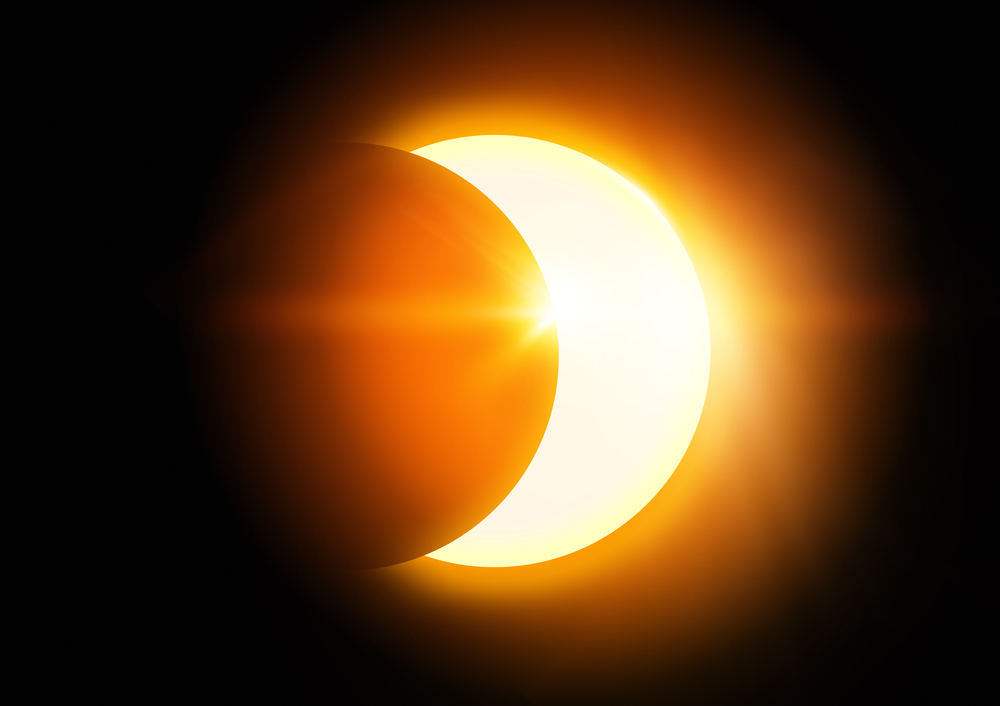
In the last month or so, if you’ve somehow been able to avoid social media, the news, socializing, or you’ve been hiding under a rock, then you might be unaware that there is a solar eclipse coming to a sky near you! And as educators, anytime an important scientific event occurs, whether it be natural or man-made, we should do what we can to seize the learning opportunity and use it to the advantage of our students.
On April 8th, educators and families around the country will have such an opportunity! Every single state will be able to see at least a fraction of the upcoming solar eclipse. What’s even more exciting is that fifteen states from Texas to Maine will be in the path of totality, which means people living in, or visiting those states, will have the chance to see a TOTAL solar eclipse.
But what’s the big deal? Don’t solar eclipses happen frequently? What’s so amazing about a solar eclipse anyway?
To find the answer to these questions and many more, I had the incredible opportunity to interview a NASA Education Specialist, Christina Milotte. Christina Milotte works on the NASA Heliophysics Education Activation Team, or NASA HEAT, a group that focuses on educating people about the Sun and its influence on the solar systemPlease use the following interview to help educate your students and colleagues on the upcoming solar eclipse, and read until the very end. You will discover invaluable facts and resources!
Christina, what is your role with NASA?
I am an education specialist, which means I provide NASA resources to educators, curate and create learning activities and curriculum, visit schools, participate in professional conferences, and go to events and do activities with the public. I used to be a public school teacher. I taught science, grades 6-12.
Why do you think people get excited about a solar eclipse?
While solar eclipses are not a rare occurrence, total solar eclipses happen only every 18 months on just a small part of Earth. Often they occur over remote parts of Earth, so a total solar eclipse that passes over a large area of populated land is a fairly rare occurrence and people get excited to see a once-in-a-lifetime event. The sky gets dark, animals change their behavior, and sharing the experience with hundreds or thousands of other people, depending on your location, can make us feel connected as humans.
Do employees of NASA get excited about solar eclipses?
They do! Not just for the reasons I mentioned above, but because there is a significant amount of science that can be done during a total solar eclipse. During a total solar eclipse you can see the Sun’s outer atmosphere, the corona, which is usually not visible. This is because the surface of the Sun, the photosphere, is so much brighter than the corona. Scientists study the Sun’s corona because it is where the solar wind originates from. The solar wind interacts with the upper part of Earth’s atmosphere, the ionosphere, causing space weather, which can interfere with communication signals and technology, and may be harmful to astronauts.
This seems like a wonderful time to get students interested in astronomy. What things should teachers discuss with their students about the eclipse?
While the mechanics of a solar eclipse (alignment of the Sun, the Moon, and Earth) are often the focus of what teachers address in the classroom, and directed by national education standards, we would like for teachers to focus more on the science I just mentioned. Heliophysics is the study of the Sun and how it affects Earth and the solar system. The Sun affects Earth systems, not just by providing heat and light, but via the solar wind which interacts with Earth’s atmosphere. The solar wind and the effects of space weather are not taught in school. We are hoping that the total solar eclipse inspires teachers and students to learn more about the Sun. The Sun goes through cycles, about every 11 years. Just like Earth has seasons, the Sun has seasons of calm “weather” and chaotic “weather.” And the Sun is very active right now. There are increased amounts of sunspots and solar storms like solar flares and coronal mass ejections. I encourage teachers to save the solar viewing glasses and use them to look for sunspots and to have students track the solar cycle, make predictions about space weather events, and learn more about the effects of space weather.
Are there certain science topics educators can teach about that connect well with the upcoming eclipse?
As I mentioned, space weather is a really cool topic to teach about. Another aspect of space weather is the aurora, referred to as the Northern Lights in the northern hemisphere. Dancing colors across the sky, seen at night most commonly in the polar regions, are an insight into how the solar wind interacts with Earth’s atmosphere. The solar wind excites the oxygen atoms in the atmosphere, causing them to glow green and red, and excited nitrogen atoms glow purple. As the Sun gets more active, it may be possible to see aurora displays at lower latitudes, even as far south as Florida. Most importantly, we want teachers to emphasize the concepts of systems science, which includes looking at how all of Earth’s systems are interconnected and how a change to one system affects other systems.
And we live in the atmosphere of a star! Without the Sun, life on Earth would not exist. Earth is the perfect distance from the Sun, allowing liquid water to nurture life, providing us with heat and light. And we have a magnetic field that protects us from a majority of the solar wind and an atmosphere that helps protect us from harmful radiation. All of these systems, together, create our home, which is the only place in the known universe that has these unique conditions. Earth is a really special place and our star, the Sun, is a really special star!
What regions of the United States have the best possibility of viewing the eclipse?
To view the total solar eclipse you have to be in the path of totality, which is about 115 miles (185 km) wide. Locations in 15 states, from Texas to Maine, will be in this path. Outside the path, observers will experience a partial solar eclipse, which is also a wonderful experience! If you live in the path of totality, or are able to travel to the path of totality, make sure to take the opportunity to experience totality, because the next total solar eclipse will not occur in the United States until 2044, in a small region of Montana and North Dakota, or until 2045, with a larger path crossing California to Florida. Or in the meantime you could get on a plane and travel to other parts of the world to see a total solar eclipse, but that is much more challenging.
Which regions have the best “views”?
One thing to consider for this total solar eclipse is cloud cover. The probability of having a cloudy day in early April is quite high in many locations across the US! Northeast weather tends to be cloudier and more unpredictable than southern weather. If you had the choice between viewing the total solar eclipse from Maine or Texas, you should choose Texas. Just last week Maine, New Hampshire, and Vermont experienced a late winter storm that covered parts of these states in 2-3 feet of snow.
As far as encouraging words for those who may experience a cloudy day, I would say, don’t feel bad about the clouds. I have known people who traveled to Antarctica on a boat to view a solar eclipse and got clouded out! So sit back and relax, tune into a live stream from a location with no clouds, and be thankful you are not on a boat in Antarctica!
Some schools are dismissing students early on the day of the eclipse. What do you think of this decision?
Because the eclipse is in the afternoon, it conflicts with many school’s dismissal times. Safety is NASA’s number one priority. Having students on buses during the eclipse would not only prevent them from experiencing the eclipse, but may pose a safety challenge with increased traffic in areas due to eclipse events. Each school district had the challenge of making the best decision for their students. We hope, here at NASA, that we have provided teachers with enough resources to support learning prior to the eclipse so that when students are at home they can safely observe the eclipse.
Where can teachers, their students, and the public purchase solar eclipse glasses appropriate for wearing during the eclipse?
We are referring to “solar eclipse glasses” as “solar viewing glasses” to communicate that the glasses can be used to view the Sun at any time, not just during a solar eclipse. Solar viewing glasses are not the same as sunglasses. They are a thousand times darker than sunglasses and block all visible and UV light. You can purchase solar viewing glasses from online retailers. But make sure that they meet the appropriate safety standard, which is ISO 12312-2. This safety standard is printed on the glasses. I would encourage the public and schools to reach out to the local library or university to see if they still have any glasses available. And if you saved glasses from the October 2023 solar eclipse or the August 2017 solar eclipse, just make sure they have not been damaged. To make sure they have not been damaged, while inside, look at a bulb with the glasses on to ensure that no light is coming through potential little pinpoints or scratches in the lenses. While you will still be able to see the the light sources through the glasses — such as the filament of an incandescent bulb or the LED point sources on your phone’s flashlight — if you see light through pinholes or scratches on the lenses, do not use them and throw the glasses away.
________________________________________________________________
Eclipse Resources For You, Your Students, and Your Students’ Families:
Find the Times at your Location
How to Determine if your Solar Viewing Glasses are Safe
NASA HEAT Website (Heliophysics and solar eclipse activities for educators)
NASA Eclipse Website (Eclipse activities and resources)
NASA Solar Eclipse Live Broadcasts: (if you can’t get to totality, this is a great option)
https://science.nasa.gov/eclipses/future-eclipses/eclipse-2024/live/
